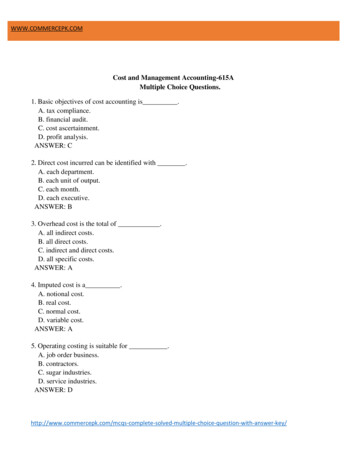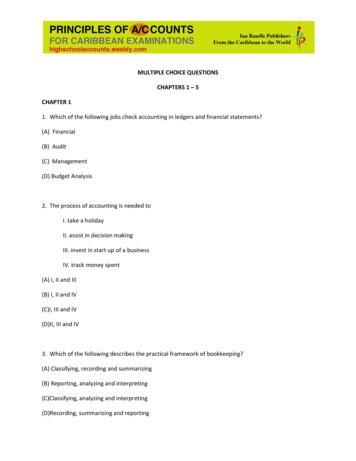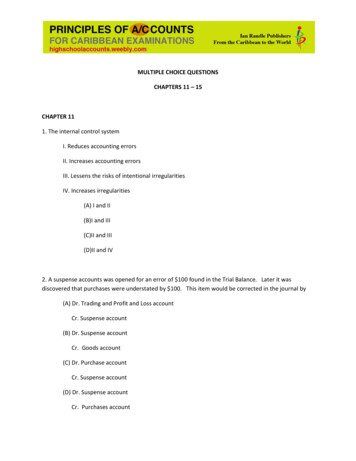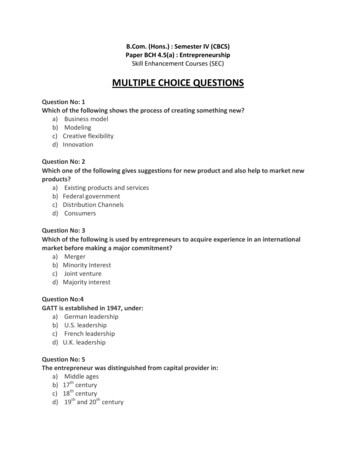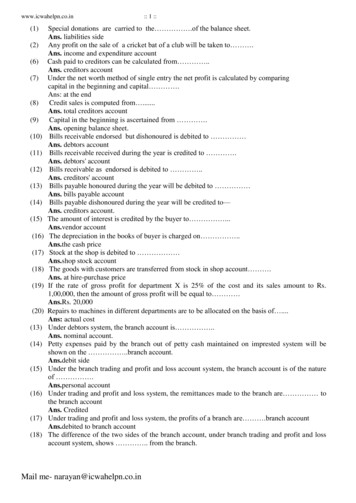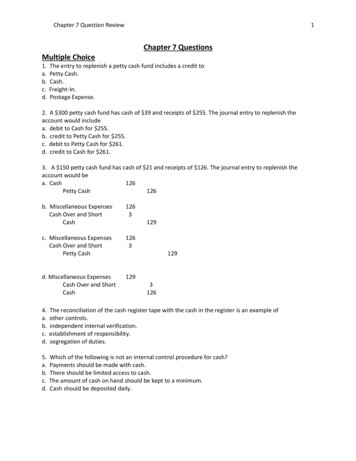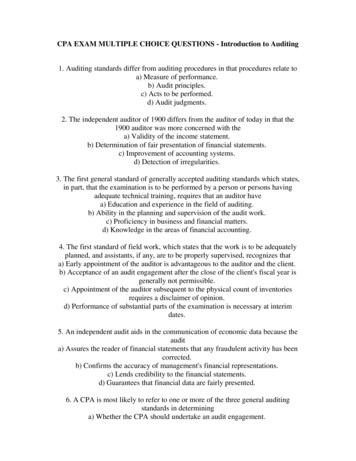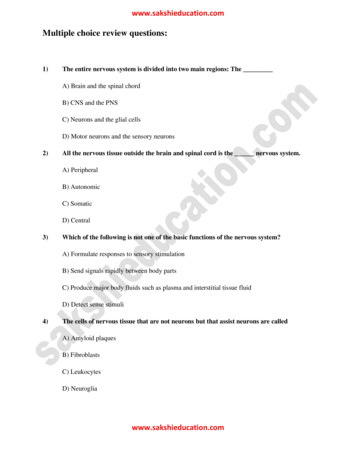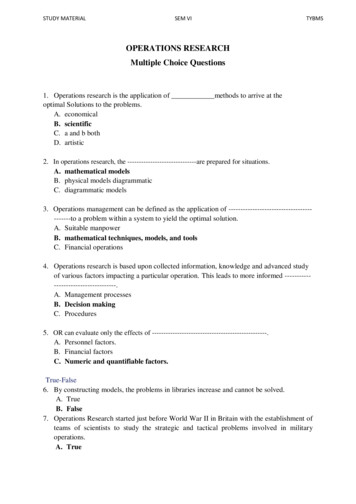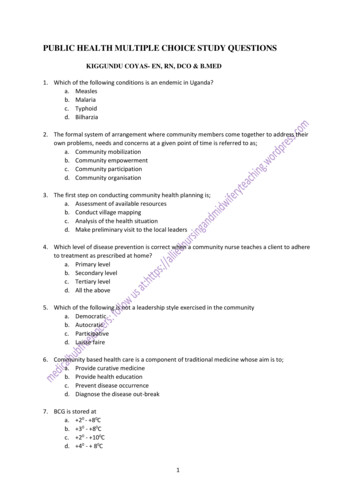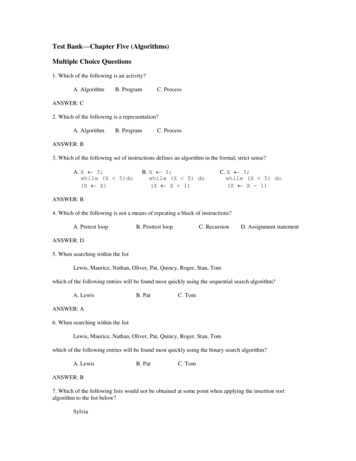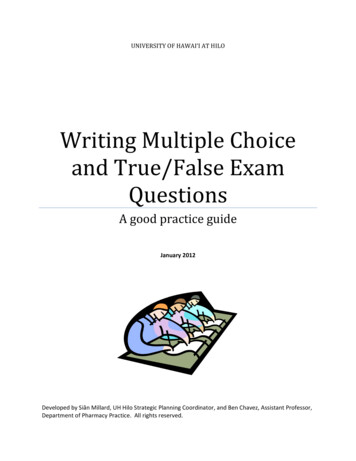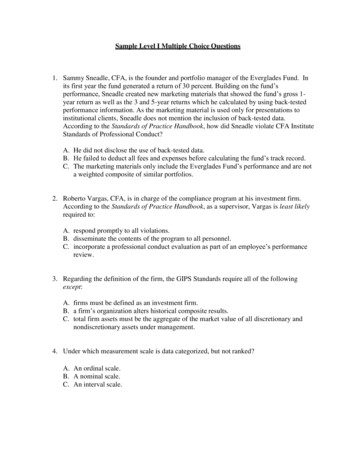
Transcription
Sample Level I Multiple Choice Questions1. Sammy Sneadle, CFA, is the founder and portfolio manager of the Everglades Fund. Inits first year the fund generated a return of 30 percent. Building on the fund’sperformance, Sneadle created new marketing materials that showed the fund’s gross 1year return as well as the 3 and 5-year returns which he calculated by using back-testedperformance information. As the marketing material is used only for presentations toinstitutional clients, Sneadle does not mention the inclusion of back-tested data.According to the Standards of Practice Handbook, how did Sneadle violate CFA InstituteStandards of Professional Conduct?A. He did not disclose the use of back-tested data.B. He failed to deduct all fees and expenses before calculating the fund’s track record.C. The marketing materials only include the Everglades Fund’s performance and are nota weighted composite of similar portfolios.2. Roberto Vargas, CFA, is in charge of the compliance program at his investment firm.According to the Standards of Practice Handbook, as a supervisor, Vargas is least likelyrequired to:A. respond promptly to all violations.B. disseminate the contents of the program to all personnel.C. incorporate a professional conduct evaluation as part of an employee’s performancereview.3. Regarding the definition of the firm, the GIPS Standards require all of the followingexcept:A. firms must be defined as an investment firm.B. a firm’s organization alters historical composite results.C. total firm assets must be the aggregate of the market value of all discretionary andnondiscretionary assets under management.4. Under which measurement scale is data categorized, but not ranked?A. An ordinal scale.B. A nominal scale.C. An interval scale.
5. The joint probability of events A and B is 32 percent with the probability of event Abeing 60 percent and the probability of event B being 50 percent. Based on thisinformation, the conditional probability of event A given event B has occurred is closestto:A. 30.0%.B. 53.3%.C. 64.0%.6. If a firm’s long-run average cost of production increases by 15 percent as a result of an 8 percentincrease in production the firm is most likely experiencing:A. economies of scale.B. diseconomies of scale.C. constant returns to scale.7. A company currently has a debt-to-equity ratio of 1.25. Common shareholder’s equity is 4,000,000, consisting of 1.5 million shares outstanding with a current price of 28/share.Part of the company’s debt currently outstanding is 1,000,000 of convertible bonds.Each 1,000 par value bond can be converted into 50 common shares at any time duringthe next three years. The coupon rate on the bonds is 6 percent with interest paidannually. If all convertible bonds are converted, the company’s debt-capital ratio isclosest to:A. 42.5%.B. 44.4%.C. 80.0%.8. A company has just issued 5 million of mandatory redeemable preferred shares with apar value of 100 per share and a 7 percent dividend. The issue matures in 5 years.Which of the following statements is least likely correct? The company’s:A. Debt/Total capital ratio will improve.B. interest coverage ratio will deteriorate.C. preferred shareholders will rank below debt holders should the company file forbankruptcy.
9. The following selected information is from a company’s most recent financial statements:SalesCost of Goods SoldInterest Expense( millions)200820072,8012,8851,9692,071123110Cash & Marketable SecuritiesAccounts ReceivableInventories108318248105286285Accounts PayableNotes Payable3615034699The 2008 cash conversion cycle, in days, is closest to:A. 23.B. 26.C. 28.10. An analyst has calculated the following ratios for a company:Number of days of receivables 48Number of days of inventory37Number of days of payables28The cash conversion cycle for the company is closest to:A. 57 days.B. 85 days.C. 113 days.11. An analyst is developing net present value (NPV) profiles for two investment projects.The only difference between the two projects is that Project 1 is expected to receivelarger cash flows early in the life of the project, while Project 2 is expected to receivelarger cash flows late in the life of the project. The slope of the NPV profile for Project 1when compared to the slope of the NPV profile for Project 2 is most likely:A. equal.B. flatter.C. steeper.
12. A company wants to determine the cost of equity to use in the calculation of its weightedaverage cost of capital. The CFO has gathered the following information:Rate of return on 3-month Treasury billsRate of return on 10-year Treasury bondsMarket equity risk premiumThe company’s estimated betaThe company’s after-tax cost of debtRisk premium of equity over debtCorporate tax rate3.0%3.5%6.0%1.68.0%4.0%35%Using the bond-yield-plus-risk-premium approach, the cost of equity for the company isclosest to:A. 10.6%.B. 12.0%.C. 16.3%.13. A company’s 100 par perpetual preferred stock has a dividend rate of 7 percent and arequired rate of return of 11 percent. The company’s earnings are expected to grow at aconstant rate of 3 percent per year. If the market price per share for the preferred stock is 75, the preferred stock is most appropriately described as being:A. overvalued by 11.36.B. undervalued by 15.13.C. undervalued by 36.36.14. An analyst gathers the following information about two companies for the year ending 31December 2008:Dividend payout ratioReturn on assetsFinancial leverageCompany 137.5%12%1.6Company 240.0%10.0%2.0Which of the following best describes the expected growth rate of Company 1? Theexpected growth rate of Company 1 compared to Company 2 is:A. lower.B. greater.C. the same.
15. An equity analyst working for a growth oriented mutual fund has a tendency to misvaluethe stocks of popular companies that she has previously recommended and the fundalready owns. Her behavior is most likely consistent with which of the following biases?A. Escalation biasB. Prospect theoryC. Confirmation bias16. A portfolio manager is evaluating investments in mortgage securities as part of aportfolio to fund long term liabilities. If she wants to minimize prepayment risk in herportfolio she is most likely to invest in:A. mortgage loans.B. mortgage passthrough securities.C. collateralized mortgage obligations.17. An investor purchases a 1-month out-of-the-money American call option on a stock. Aweek later, the stock price is less than the call option strike price. The time value of theoption is most likely:A. Zero.B. A positive amount.C. A negative amount.18. Compared to investors with long investment time horizons, investors with shortinvestment time horizons most likely require:A. less liquidity and less emphasis on capital appreciation.B. more liquidity and less emphasis on capital appreciation.C. less liquidity and greater emphasis on capital appreciation.19. A primary motivation for investment in commodities is most likely the:A. positive correlation of commodities with unexpected inflation.B. positive correlation of commodities with stock and bond investments.C. positive volatility of commodities relative to stock and bond investments.
20. Which of the following statements regarding the Markowitz efficient frontier is leastlikely to be correct? The optimal portfolio for:A. an investor is the portfolio that lies on the efficient frontier and provides her with thegreatest level of utility.B. an investor is found at the point of tangency between the efficient frontier and aninvestor’s highest utility curve.C. a more risk-averse investor will lie inside the efficient frontier but will lie outside theefficient frontier for a less risk-averse investor.Answers are provided beginning on the next page.
Answers to Sample Level I Multiple Choice Questions1. Sammy Sneadle, CFA, is the founder and portfolio manager of the Everglades Fund. Inits first year the fund generated a return of 30 percent. Building on the fund’sperformance, Sneadle created new marketing materials that showed the fund’s gross 1year return as well as the 3 and 5-year returns which he calculated by using back-testedperformance information. As the marketing material is used only for presentations toinstitutional clients, Sneadle does not mention the inclusion of back-tested data.According to the Standards of Practice Handbook, how did Sneadle violate CFA InstituteStandards of Professional Conduct?A. He did not disclose the use of back-tested data.B. He failed to deduct all fees and expenses before calculating the fund’s track record.C. The marketing materials only include the Everglades Fund’s performance and are nota weighted composite of similar portfolios.ANSWER: A“Guidance for Standards I-VII,” CFA Institute2009 Modular Level I, Vol. 1, pp. 64-65Study Sessions 1-2-aDemonstrate a thorough knowledge of the Code of Ethics and Standards of ProfessionalConduct by applying the Code and Standards to situations involving issues ofprofessional integrity.The CFA Institute Standard on Duties to Clients, Standard III (D), prohibitsmembers/candidates from making any statements that misrepresent the performanceachieved by them or their firms and requires every reasonable effort to be made to ensurethat performance information is fair, accurate, and complete. By failing to clearlyidentify the simulated performance results, Snead violated the standard. Snead shouldhave disclosed the fact that the returns were generated only in one year of the fund’soperation and the other performance information was back-tested.Standard III (D) Duties to Clients: Performance Presentation.2. Roberto Vargas, CFA, is in charge of the compliance program at his investment firm.According to the Standards of Practice Handbook, as a supervisor, Vargas is least likelyrequired to:A. respond promptly to all violations.B. disseminate the contents of the program to all personnel.C. incorporate a professional conduct evaluation as part of an employee’s performancereview.ANSWER: B“Guidance for Standards I-VII,” CFA Institute2009 Modular Level I, Vol. 1, pp. 76-78
Study Sessions 1-2-aDemonstrate a thorough knowledge of the Code of Ethics and Standards of ProfessionalConduct by applying the Code and Standards to situations involving issues ofprofessional integrity.According to Standard IV (C) Duties to Employers: Responsibilities of Supervisors,members must make reasonable efforts to detect and prevent violations of applicablelaws, rules, regulations, and the Code and Standards. Supervisors must disseminate thecontents of the program to appropriate personnel. It is unnecessary to disseminate thecontents of the program to all employees.3. Regarding the definition of the firm, the GIPS Standards require all of the followingexcept:A. firms must be defined as an investment firm.B. a firm’s organization alters historical composite results.C. total firm assets must be the aggregate of the market value of all discretionary andnondiscretionary assets under management.ANSWER: B“Global Investment Performance Standards,” CFA Institute, 20052009 Modular Level I, Vol. 1, p. 134Study Session 1–4–bDescribe the scope of the GIPS standards with respect to an investment firm’s definitionand historical performance record.A reorganization of a firm does not permit any alteration of historical composite results.A firm is defined as a distinct business entity and does not include fund sponsors orconsultants.Total firm assets must be the aggregate of the market value of all discretionary andnondiscretionary assets under management within the defined firm. This includes bothfee-paying and non-fee-paying assets.4. Under which measurement scale is data categorized, but not ranked?A. An ordinal scale.B. A nominal scale.C. An interval scale.ANSWER: B“Statistical Concepts and Market Returns,” Richard A. Defusco, Dennis W. McLeavey,Jerald E. Pinto, and David E. Runkle2009 Modular Level I, Vol. 1, page 242Study Session 2-7-a
Differentiate between descriptive statistics and inferential statistics, between a populationand a sample, and among the types of measurement scales.Data is categorized, but not ranked under a nominal scale. Under an ordinal scale data isranked, while under an interval scale, data is ranked and separated by equal intervals.5. The joint probability of events A and B is 32 percent with the probability of event Abeing 60 percent and the probability of event B being 50 percent. Based on thisinformation, the conditional probability of event A given event B has occurred is closestto:A. 30.0%.B. 53.3%.C. 64.0%.ANSWER: C“Probability Concepts,” Richard A. Defusco, Dennis W. McLeavey, Jerald E. Pinto, andDavid E. Runkle2009 Modular Level I, Vol. 1, p. 325Study Session 2-8-d, eDistinguish between unconditional and conditional probability.Calculate and interpret 1) the joint probability of two events, 2) the probability that atleast one of the two events will occur, given the probability of each and the jointprobability of the two events, and 3) a joint probability of any number of independentevents.The conditional probability of A given that B has occurred is equal to the jointprobability of A and B divided by the probability of B. In this case, P(A B) P(AB)/P(B) 32%/50% 64.0%.6. If a firm’s long-run average cost of production increases by 15 percent as a result of an 8 percentincrease in production the firm is most likely experiencing:A. economies of scale.B. diseconomies of scale.C. constant returns to scale.ANSWER: B“Output and Costs,” Michael Parkin2009 Modular Level I, Vol. 2, p. 143Study Session 4-17-dExplain the firm’s production function, its properties of diminishing returns and diminishingmarginal product of capital, the relation between short-run and long-run costs, and howeconomies and diseconomies of scale affect long-run costs.
As a company faces diseconomies of scale when long-term average production costs rise fasterthan increases in production. When diseconomies of scale are present, the LRAC curve slopesupward. The
Sample Level I Multiple Choice Questions 1. Sammy Sneadle, CFA, is the founder and portfolio manager of the Everglades Fund. In its first year the fund generated a return of 30 percent. Building on the fund’s performance, Sneadle created new marketing materials that showed the fund’s gross 1-
